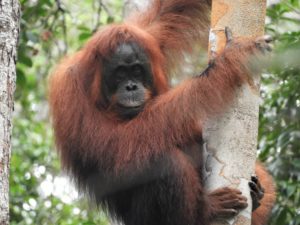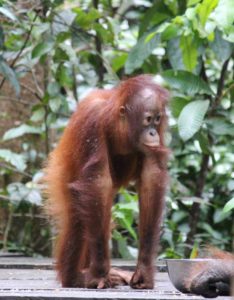Orangutan Encounters: An interview with Gary Shapiro
On a past voyage, our guests were fortunate enough to travel with Gary Shapiro, one of the world’s premier specialists in the study and conservation of the majestic orangutan.
On this voyage, Gary and our guests visited two of the three orangutan viewing areas in the Sekonyer River system in Tanjung Puting National Park in Central Indonesian Borneo (Kalimantan Tengah). Guided by Gary, our guests saw wild orangutans along the river and witnessed the feeding of numerous orangutans in each age-class who came to the feeding sites at Tanjung Harapan and Pondok Tenggui. 
Sadly, destruction of habitat has driven these charismatic creatures to the very brink of extinction. So, what can we learn from orangutans, and how can we help them to flourish? Guest Lecturer Gary Shapiro, President & Co-Founder of Orang Utan Republik Foundation shares his experiences with us.
People argue between orangutans and chimpanzees as our closest ancestors – which is true? Correctly speaking no living great ape – orangutan or chimpanzee – is our closest ancestor. We shared a common ancestor with chimpanzees, bonobos, gorillas and orangutans. Based on the genetic data, we are more closely related to chimpanzees and bonobos (pygmy chimps) than to orangutans. We share approximately 99% of our genes with chimpanzees and 97% with orangutans.
Why did you choose to devote your life to orangutans? As someone who has become knowledgeable (but always learning) about this species and its role in nature and relationship with our own species, I wanted to make sure it does not go extinct. I realized I can make a difference and wanted to enrol and encourage Indonesian people to care about orangutans so they will save them from extinction in the wild.
What species of orangutan do you specialise in? I have worked with both Bornean (Pongo pygmaeus wurmbii) and Sumatran (Pongo abelii) orangutans in the 43 years I have studied and conserved orangutans. I taught linguistic symbols to Aazk, a captive juvenile Sumatran orangutan (1973-1975), sign language to Rinnie, an adult female Bornean orangutan, and signs to Princess, Pola, Hampas, and Rantai (1978-1980).
 One of your subjects, Princess, is famous for adopting you as a father figure, and learning over 30 signs. Tell us about it. Princess actually bonded with me first. I had noticed her in the holding cage for the youngsters to keep them safe from the bush pigs. When I was ready to select a signing student, she actually was the first one to leap out to the cage into my arms. My parental instincts for my newly-adopted daughter came after that, when she stayed with me at the guest house where I lived.
One of your subjects, Princess, is famous for adopting you as a father figure, and learning over 30 signs. Tell us about it. Princess actually bonded with me first. I had noticed her in the holding cage for the youngsters to keep them safe from the bush pigs. When I was ready to select a signing student, she actually was the first one to leap out to the cage into my arms. My parental instincts for my newly-adopted daughter came after that, when she stayed with me at the guest house where I lived.
What are one or two of the most remarkable experiences you’ve had with orangutans? Perhaps one of the most remarkable experiences I had with an orangutan was when Rinnie, a free-ranging, ex-captive adult female orangutan, wanted me to get affectionate with her after my teaching her signs for a little over a week. She built a ground nest, took me by the hand, laid down in the nest, and pulled me to get close to her. I was surprised that she wanted more from me than food or sign learning lessons.
What are one or two of the most unusual or surprising things that you’ve learned about orangutans? I learned how cunning orangutans can be as they deceive you into thinking they are interested in interacting with you, face-to-face, then carefully they take one of their feet behind you and attempt to pick your pockets of food and other treats. I also have been surprised to learn they have hearty digestive systems when they eat soap like whipped cream, or eat highly acidic fruits and tree sap that can “burn” the skin dark.
 Orangutans are in trouble. What do you feel are the main challenges facing orangutans today? Loss of habitat is the biggest threats facing orangutans today. Lowland forest and peat swamp forests, especially, are desirable for conversion to agricultural estates for many products. The lowlands of both Borneo and Sumatra are the places where most orangutans are found. The biggest challenge is securing large tracts of land where orangutans are found and preventing them from being converted both legally and illegally to agriculture or other uses (gold mining, for example).
Orangutans are in trouble. What do you feel are the main challenges facing orangutans today? Loss of habitat is the biggest threats facing orangutans today. Lowland forest and peat swamp forests, especially, are desirable for conversion to agricultural estates for many products. The lowlands of both Borneo and Sumatra are the places where most orangutans are found. The biggest challenge is securing large tracts of land where orangutans are found and preventing them from being converted both legally and illegally to agriculture or other uses (gold mining, for example).
In your opinion, what can we, as expedition travellers do to help orangutans today? As tourists, we can visit orangutans in a responsible manner to show the government and business world that such ecotourism works. Following the proper protocols is very important to keep the numbers of visitors manageable, minimize any direct contact with the orangutans (for health and safety of both human and orangutan), and follow the directions of the professional guides. Providing guests with briefings concerning the Do’s and Don’ts is also a very important responsibility of each tour operator. Also, to make a lasting difference, each tourist who has seen orangutans can become a spokesperson to others who haven’t seen them in the wild. Tourists should visit the websites of NGOs that are helping to save orangutans for more information and to learn about other ways they can help.
In your opinion, how can we educate and motivate visitors to this area to help conserve orangutan habitats? The best way is to choose one or more orangutan support groups that are working on the ground to save orangutans and their habitat. Many have very good websites with information that can educate prospective tourists. Some groups, like The Orangutan Project (orangutan.org.au) and Orangutan Odysseys (orangutanodysseys.com) give people the chance to prepare to visit orangutans in the most ecologically sensitive way, help people raise funds to visit orangutans in the field, and help support the many projects currently saving the forest and species. By joining an organization and following their social media channels, you can also sign on-line petitions that can make a big difference with they are sent to government officials.
An end-note from Gary
Saving orangutans, other wildlife and rainforest will take concerted action by many stakeholders to overcome the status quo. Helping effective NGOs exert leverage in purchasing large tracts of available forest and peat areas can help 1) keep wildlife safe, 2) keep ecological systems intact, and 3) keep carbon stores in the ground. The last aspect is important if we are to manage the climate change phenomenon. We can’t expect the local governments to do this without the partnerships or opportunities to educate decision-makers in the most appropriate way. It takes funding to acquire such forested land, and foundations and philanthropists are vital to support these efforts.






